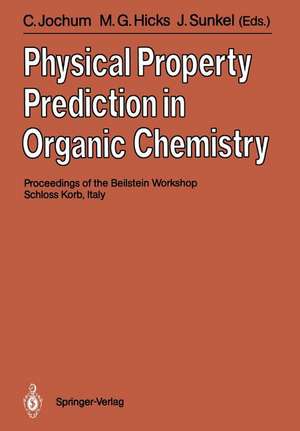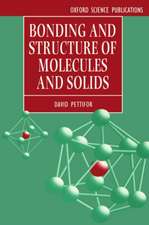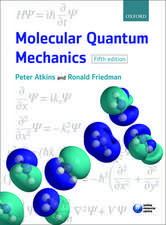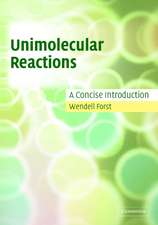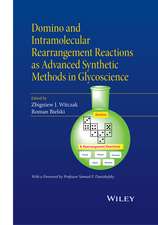Physical Property Prediction in Organic Chemistry: Proceedings of the Beilstein Workshop, 16–20th May, 1988, Schloss Korb, Italy
Editat de Clemens Jochum, Martin Hicks, Josef Sunkelen Limba Engleză Paperback – 15 ian 2012
Preț: 657.90 lei
Preț vechi: 774.00 lei
-15% Nou
Puncte Express: 987
Preț estimativ în valută:
125.89€ • 131.77$ • 104.78£
125.89€ • 131.77$ • 104.78£
Carte tipărită la comandă
Livrare economică 01-15 aprilie
Preluare comenzi: 021 569.72.76
Specificații
ISBN-13: 9783642741425
ISBN-10: 3642741428
Pagini: 572
Ilustrații: X, 554 p.
Dimensiuni: 170 x 244 x 30 mm
Greutate: 0.9 kg
Ediția:Softcover reprint of the original 1st ed. 1988
Editura: Springer Berlin, Heidelberg
Colecția Springer
Locul publicării:Berlin, Heidelberg, Germany
ISBN-10: 3642741428
Pagini: 572
Ilustrații: X, 554 p.
Dimensiuni: 170 x 244 x 30 mm
Greutate: 0.9 kg
Ediția:Softcover reprint of the original 1st ed. 1988
Editura: Springer Berlin, Heidelberg
Colecția Springer
Locul publicării:Berlin, Heidelberg, Germany
Public țintă
ResearchDescriere
For more than 100 years the Beilstein Handbook has been publishing checked and evaluated data on organic compounds. It has become the major reference book for the chemical and physical properties of organic com pounds. The prediction of these physical properties was the subject of the Beilstein workshop. The ability to predict physical properties is for several reasons of great interest to the Beilstein Institute. It is of primary importance to be able to check the abstracted data for accuracy and to eliminate simple mistakes like typing errors. Presently all the work whether manuscript writing or evaluation of data is carried out manually. This is very time consuming, with the entry of Beilstein into electronic data gathering and publication, the opportunity for computerized consistency checking has become available. Contrary to belief, when one examines the Beilstein Handbook or Chemical Abstracts there is a dearth of chemical information. There are a great many compounds but few are well defined resulting in large gaps in the information available to the chemist. These information gaps could be filled by using algorithmic methods to estimate the properties of interest. An important question to answer is "What is the chemist's reaction to estimated data?" Will he accept it for use, within limits defined by the method, or will it be unacceptable and therefore detrimental for the data base. However if one could partly fill gaps in the data base the increase in the power of the search techniques would be marked.
Cuprins
Chemical Information — Promotion of Innovation in Science and Technology.- The Importance of Data Estimation for the Beilstein Information System.- Data About Data.- Questions and Issues About the Process of Estimating Properties of Chemicals.- Numeric Features of the Beilstein Database on STN.- The Thermodynamics Research Center Databases on Original Measurements and Evaluated Data.- Computer-Aided Selection of Chemicals for Biological Testing: Estimation of Biological Activity.- Physico-Chemical Property Data Bank of the Prague Institute of Chemical Technology.- Molecular Orbital and Force-Field Calculations for Structure and Energy Predictions.- Estimation of Thermodynamic Properties of Organic Compounds in the Gas, Liquid, and Solid Phases at 298.15 K.- Empirical Methods for the Calculation of Physicochemical Data of Organic Compounds.- Statistical Thermodynamics: Current Perspectives and Limitations of Fluid Property Estimation.- One and Multidimensional Numerical Interpolation Methods.- A Fuzzy Approach to Predicting Chemical Data from Incomplete, Uncertain and Verbal Compound Features.- Ranking and Clustering of Chemical Structure Databases.- Prediction of Physicochemical Properties of Organic Compounds from Molecular Structure.- Current Problems in Quantitative Structure Activity Relationships.- Computation of Volumes and Surface Areas of Organic Compounds.- Total System of Molecular Design.- Physico-chemical Data Estimation for Environmental Chemicals.- Application of Molecular Topology for the Estimation of Physical Data for Environmental Chemicals.- Industrial Use of Group Contribution Methods for Estimation of Physical Properties.- Experience with the Development of a Group-Contribution Equation of State for the Prediction of Physical Properties for Process Engineering Purposes.- Prediction of Mixture Properties Using UNIFAC.- Computer Analysis of Thermochemical Data of Organic Compounds.- Prediction of Physicochemical Properties Using a Semi-Empirical Group Contribution Approach.- Estimation of the Aqueous Solubility of Organic Compounds.- Recommended gE-Model Parameters by Simultaneous Fitting of Different Excess Properties.- The Arizona Database: An Aqueous Solubility Database for Nonelectrolytes.- Correlation and Extrapolation in Chemical Engineering of Vapour Pressure Data Using Thermal Data.- Establishing Consistent Thermodynamic Data on Vaporization Equilibria for Organic Compounds.- Critical Compilation of Heat Capacities of Liquids.- PETRA: Software Package for the Calculation of Electronic and Thermochemical Properties of Organic Molecules.- Workshop Review and Epilogue.
